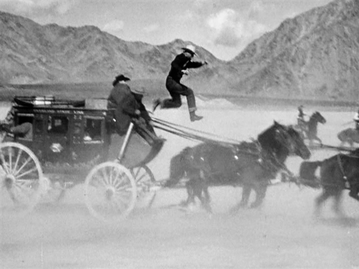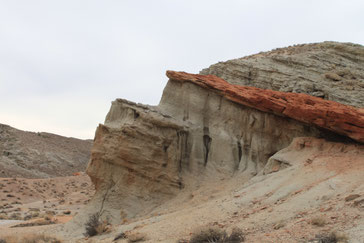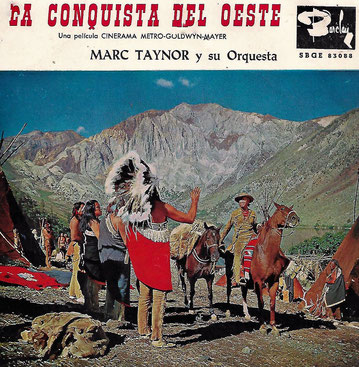John Wayne in California
Point mugu

Point Mugu near Los Angeles doubled for Nome, Alaska, for the beach scenes of John Wayne's North to Alaska. A set was constructed on the far end of the beach...

...with the distinctive Mugu Rock visible in some scenes. John Wayne had connections to the Naval Base at Point Mugu. He used that same stretch of Californian beach for the closing scene of The Green Berets, when he tells the orphan kid "You're what this is all about".
Vasquez Rock

Trekkies call it "Kirk Rock" but John Wayne fans recognize the striking formation as Vasquez Rock. John Wayne passes it for the first time in 1935 in The Lawless Range when...

...the singing cowboy is strumming the guitar. John Wayne passes Vasquez Rock as a matter of introduction to his adventures on The Lawlass Range as the scenery soon changes, and, in a wonderful manner, arrives in the Alabama Hills. However, John Wayne returned...

...to the natural area park of Vasquez Rock in Agua Dulce, 10 years after the B-western Lawless Range, for his A-picture Daktoa at Vasquez Rock. Actually...

...just this small portion of a stagecoach ride was shot at Vasquez Rock Natural Area Park, at 10700 W. Escondito Canyon Road, as most of the John Wayne western Dakota was filmed on the stages of Republic Pictures.
victorville

The chase in Stagecoach was shot in three days on the dry lakebed, east of Victorville. John Ford had used the Lucerne Dry Lake before for the landrush scene in his silent western Three Bad Men. Highway 247 travels through it. Ford filmed the chase on both sides of the road. Yakima Canutts stunts...

...were accomplished on the left side of the road, to the South...

...while the cavalry coming to the rescue was filmed on the right side of the road (looking north), with the San Bernardino Mountains in the background. Ford, Wayne, and Canutt stayed at the Green Spot Motel in Victorville.
Newhall

In Stagecoach, to make the transition between Monument Valley and the flats at Victorville, Ford came back to another location he had used before: Beale's Cut in Newhall. In 1938, the Sierra Highway was the main roadway from Los Angeles to Newhall.

The cut in the mountain suffered a partial collapse during the 1994 earthquake. Sierra Highway is now closed.
kernville

John Wayne had been to Kernville no less than ten times for B-Westerns between 1933 and 1935. He returned for the scene in Stagecoach, where the coach crosses the river. Yakima Canutt had done countless stunts at the lagoon area, south of the current dam.

The largest artifact of the Kern Valley Museum in Kernville is the "mud wagon" Cannut used to make the river crossing scene work. It is slightly different from the Concord type of stagecoach. Cannut had dressed this wagon to make it look like the stagecoach. According to some sources, the rivercrossing was shot on Tilly Creek.

The Kern River was a favorite location for stunt scenes involving jumping horses into the water. One year after the river crossing in Stagecoach, Canutt was back doubling Wayne in Dark Command: he drove a team of horses over the cliff and into the river.

Old Kernville was covered by the Isabella Lake in 1953. Several of the original buildings used in westerns up to that point were moved to the present location of Kernville. Wayne's biggest movie in Kernville had been In Old California. „It was a beautiful little western town close to the Kern River,” he remembered years later, „so it had pleasant vegetation and trees in its square. It is now at the bottom of a man-made lake to keep it from interfering with progress. “
red rock canyon

John Wayne made two films in Red Rock Canyon: CA-14 cuts directly across Red Rock Canyon State Park where countless westerns were shot. The Lawless Frontier in 1934 has an unusual chase scene: Wayne follows the baddie by foot, and because of the extreme heat, they are only able to walk...

...until Wayne finally catches up with the bad guy at a poisoned water hole - which was located right here, in front of this spectacular rock formation, in Hagen Canyon.

He was back in Red Rock Canyon five years later forPals of the Saddle. This publicity shot of the three Mesquiteers, Wayne with Max Terhune and Ray Corrigan, was taken...

...right here, up in Hagen Canyon. That's the terrain John Wayne location hunters are looking for. From the car park, a hiking trail leads to Hagen Canyon. This Pals of the Saddle location is close to what locals call Cooper's Gulch, the site of Gary Cooper's shoot-out in Man of the West.

Up in Hagen Canyon, those Pals of the Saddle step down from their horses and run up...

...this rock right here. All locations of this Three Mesquiteers sagebrusher are in close distance.

The Three Mesquiteers then trade shots with the bad guys, shooting down this rock...

...all in long shot. What is made to appear as the "State Border" in Pals of the Saddle is actually just a gap between these outcroppings.

They just turned the cameras around for this motif: Max Terhune and Ray Corrigan are hiding behind this significant rock...

...which is still to be found in Hagen Canyon.
Apple valley

Somewhere in Sonora was shot at Deadman Hill, in the southern portion of the Granite Mountain, at the eastern edge of Apple Valley. Highway 18 runs along the southern edge of the hills. They used the then unpaved highway, heading west. When in Apple Valley, Wayne stayed at the Apple Valley Inn. When Roy Rogers and Dale Evans became residents of Apple Valley, they leased the inn and restaurant and renamed it Roy Rogers Apple Valley Inn.
san francisco bay

Coming up on the north coast of San Francisco Bay, in Marin County, you will find China Camp, on the shore of San Pablo Bay, now a state park. It was the principal location of John Wayne's Red Scare movie Blood Alley. This photograph was taken from the same hill that...

...this background shot for the main titles of Blood Alley was accomplished from.

In 1955, the Chinese American shrimp-fishing village became the Red China town that John Wayne must evacuate in Blood Alley. The park is located in...

...San Rafael. The original pier as well as most of the historic buildings you will see in John Wayne's Blood Alley are still there to enjoy. In the background of this 2023 photograph you will recognize the location...

...of the Chinese Wall the art department fabricated. The makers of Blood Alley put the shell of a castle on the hillside above China Camp. Remains of the fortifications put there to hold up the wall can still be found.

Rat Rock, the disctinctive reef, where the villagers lay a trap for the patrol boat, is still visible just off the camp. The natural locations of John Wayne's Blood Alley remain untouched after seven decades.

The art department of the John Wayne production Blood Alley utilzed this building at the pier of China Camp State Park to make it look like the entrance to the Chinese village. The 1,514-acre park was established in 1976.
Point san pablo

For the ship graveyard sequences in Blood Alley, the John Wayne production used real wrecks on the mudflats of Richmond. The marina of Point San Pablo at Stenmark Drive is still popular with boat owners.

As John Wayne's riverboat reaches the Chinese ship graveyard in Blood Alley, it actually plows into Point San Pablo. The jetties are made from old boats. The harbor was created...

...in 1939, when a breakwater was build out of old steel schooners sunk in place. Many steam schooners found their last resting place here. It became the perfect location for the sequence in Blood Alley, when skipper John Wayne breaks up a wreck for firing wood to feed his own steamboat.

...the locals also claim that one interior scene of Blood Alley was actually shot in the historic restaurant in Point San Pablo (when John Wayne is instructed by the elders of the village about the job at hand), which was then bustling with sailors and fishermen working on ships docked along the San Pablo Peninsula. Now the Nobilis restaurant stands in the place of the historic one.
Stockton

During the making of Blood Alley, the crew was largely based in San Pablo Harbor. The stars stayed at the Hotel Stockton at 133 E Weber Ave in Stockton. According to some sources, some scenes that supposedly took place inside the riverboat, where shot in the hotel's large halls. The grand building was opened in 1910 and had been popular with entertainers. Locals remember that John Wayne would sign autographs until there wasn’t any more to sign.

John Wayne and the stars of Blood Alley would sometimes frequent the then popular Stockton bar Chet’s. The old glory is gone, the place is now Growers Hall at 122 N Wilson Way.
San Rafael

During the shooting of Blood Alley, John Wayne strained his back and was hospitalized at Marin General Hospital, 3950 Civic Center Drive, San Rafael.
sacramento

The giant paddlewheel boat used in Blood Alley may have found its final resting place. It makes for a great roadside attraction just a little outside Sacremento, along Garden Highway. Originally named the Putah, it was built in 1942 and put to work by John Wayne's Batjac as the biggest prop in 1955 in the anti-communist movie Blood Alley. The boat's job was a big one: rescue Chinese villagers and get them safely to Hongkong... with a little help from the skipper, John Wayne.

Imagine John Wayne at the helm. After the river boat did it's duty in Blood Alley, it changed hands several times, sank to the bottom of the river and even burned, then left abandoned on the shores of the Sacremento River. The final faith of the historic vessel is yet to be determined.
mammoth

Coming up on US-395, that's Convict Lake on your left. It was the scenic background for the first moments in How the West Was Won, as James Stewart arrives in the Indian camp ...

...and then paddles off in a canoe from right here.
toulumne county

The B-movies in the 30's were usually shot within close range of the Poverty Row Studios. However, John Wayne's string of Universal pictures had a bigger budget than the other quickies. That's how the lumberjack drama Conflict in 1936 could afford location shooting in Tuolumne County near Sacramento. The production used the historic western street of Columbia State Historic Park and...

....utilized several structures of the historic downtown Columbia. The Columbia State Historic Park includes around 30 buildings dating back to the California Gold Rush. It is probably most famous for its use in High Noon. However, the Duke got there 15 years before the Coop. In 1936, the John Wayne adventure movie Conflict...

...used the look of the Columbia State Historic Park to good advantage. It was declared a National Historic Landmark in 1961. The John Wayne B-movie Conflict also put to use another prominent prop which would be used in High Noon years later...

...ant that's the trusty red fire engine, named the "Papéete". In High Noon, when the three gunnies ride down Main street, they pass the fire engine house where a man is just sweeping her clean. 15 years before that, she was played a sizeable part in a hilarious sequence of John Wayne's Conflict.

Even when in use as a prop in John Wayne's Conflict, the historic fire engine was already a 100-year-old veteran of the fire departement. For years, the Papéete could be admired in the actual engine house at the historic main street of Columbia State Park. It has now been removed to the fire departement to become part of an exhibition.
For the railroad scenes, the production move to nearby...

...Jamestown: The Railtown 1897 State Historic Park has been a popular site for motion picture filming ever since 1919. In 1937, the John Wayne Universal picture Conflict benefitted from the combinations of scenery, equipment, and railroad action possible. The scenes of Ward Bond arriving at the trainstation where shot in what is now the railroad museum, using the star locomotive Number 18.
The same locomotive appeared in numerous films and TV specials. Just two years after the John Wayne oater, No. 8 was featured in Errol Flynn's Dodge City, and in the year after that, in The Return of Frank James, starring Henry Fonda.
donner lake

Donner Lake, the location for Island in the Sky, in production between February 2 to April 1953, was his highest up north in California. The valley, six miles from Truckee in the Sierra Nevadas, served as an airplane runway during the summer. When Wayne’s company acquired the movie rights, they had made tentative plans to shoot on location in Canada. Wayne also considered filming in the San Bernardino Mountains, a place he knew well. Lack of snow that year forced them to move to Northern California.
san bernardino mountains

The Shepherd of the Hills was his first film in the San Bernardino Mountains. During production from September 9 till November 14 1940. Wayne crashed his car one morning coming up in a hurry from Arrowhead where he had spent the night with Marlene Dietrich.

The Shepherd of the Hills, also his first Technicolor film, was shot near Big Bear Lake, at Moon Ridge, Cedar Lake and Bartlett Lake.

He made his comeback to San Bernardino 20 years later: In the luberjack scene of North to Alaska, the mill set that was built for Shepherd of the Hills on the Cedar Lake can be spotted in the background. The log structures were standing for decades unteil they were removed.
coloma

John Wayne was at Sutter’s Mill, in Coloma, California, to do a commercial for Great Western Bank, on October 28, 1977. Marshall Gold Discovery State Historic Park marks the location of the discovery of gold at Sutter's Mill in 1848.
sequoia national park

The happy ending of The Big Trail was shot in California's Sequoia National Park, home of giant sequoias. The actual location was south of Kings Canyon. Director Raoul Walsh chose the Big Tree Grove because it seemed to him that nature hat there provided the movie with a cathedral of all ages.

At the end of his career, 53 years after The Big Trail, John Wayne returned to the Sequoia National Park. He picked the location for one of the Great Western Savings commercials himself. When he looked up to the largest trees in the world, he said in awe it's "like being in a giant cathedral."
©All text content on this website is protected by copyright and other intellectual property laws. No part may be reproduced without the prior written permission. All photos courtesy of Roland Schaefli, unless otherwise stated.
This website is in no way associated with the John Wayne Estate or business enterprises. Go to johnwayne.com to find the official website and to https://johnwayne.org/ to read about the wonderful John Wayne Cancer Foundation.
more john wayne locations to scout
If you like this site, you'll like the book: the first comprehensive guide to the John Wayne Locations, with hundreds of then-and-now photos, unpublished behind-the-scenes-pictures and detailed tour descriptions
Tracking John Wayne: The complete Tourguide
Find directions to locations and anecdotes from the Duke's movie sets in this new publication from McFarland, available at bookstores and online shops
For all locations mentioned on this website, the book offers behind-the-scenes stories, making-of anecdotes and never before published photos

